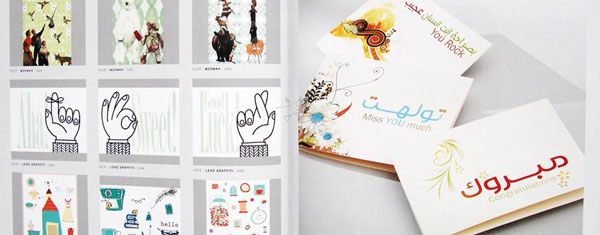1000 More Greetings by Aesthetic Movement
Article by Martin Gibson – @embody3d @martingibson – 23.12.2010
So often I am asked to design invitations, posters and other assorted media for friends, family and of course clients. I seem to be the default go-to person for just about any kind of stationary, which is both good and bad. Of course these people don’t the understand the toil and creativeness required to produce “professional design”. Their assessment of design is a quick simple Microsoft Word or Publisher job which might take 5-10 minutes for an invitation for instance. Words like vector, Adobe Illustrator, CMYK, RGB, Dimensions are some kind of foreign language to these people making that process all the more difficult. I can’t speak for every designer, but I certainly go through peaks and troughs when designing. Sometimes I can be on a role and have 10 cool concepts in half an hour, whereas other days I can spend hours and hours trying to develop just 1 concept and it might not even look any good anyway.
Like yourself I am often crawling through web image repositories like Google Images, Flickr and when I am feeling arty, Deviant Art. But there is so much junk on these repositories as it is filtered by algorithms and not by humans. Humans that can differentiate between a design studio piece and a design made in Microsoft Word 2003 by Uncle Fred in using my favourite font Comic Sans. Of course I don’t want to steal other peoples designs, but I just need a starting point or a gist of inspiration…you know I mean.
I came across ‘1000 More Greetings’ by Aesthetic Movement, a think tank for smart and creative collaborations, published by Rockport. Simply put ‘1000 More Greetings’ conveniently and beautifully packages some of the best correspondence cards for all occasions. The designs are just incredible and it of course has far more scope and quality that an image repository could serve you. The media is split up into 5 categories which include:
- Greeting Cards
- Custom Greetings
- Promotions
- Announcements
- Invitations
All the designs are very modern in that kind of quirky fun way; don’t expect any traditional cards for Grandma here. There are all sorts of materials utilised included hundreds of different types of card with different transparencies, textures and colours and not to mention more radical materials like metal, wood and plastic being used. The designs themselves are compiled from hundreds of design houses and freelancers from around the world, making the book very international, radical and diverse. I am confident this book could cover all your card requirements for the next 5-10 years, I strongly recommend it for any graphic design enthusiast!
[rating:5]




